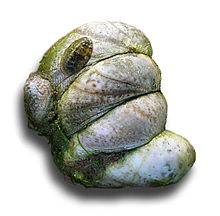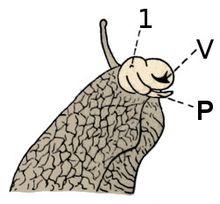
Helix is a genus of large, air-breathing land snails native to the western Palaearctic and characterized by a globular shell.

The female reproductive system is made up of the internal and external sex organs that function in the reproduction of new offspring. The human female reproductive system is immature at birth and develops to maturity at puberty to be able to produce gametes, and to carry a fetus to full term. The internal sex organs are the vagina, uterus, fallopian tubes, and ovaries. The female reproductive tract includes the vagina, uterus, and fallopian tubes and is prone to infections. The vagina allows for sexual intercourse and childbirth, and is connected to the uterus at the cervix. The uterus or womb accommodates the embryo which develops into the fetus. The uterus also produces secretions which help the transit of sperm to the fallopian tubes, where sperm fertilize ova produced by the ovaries. The external sex organs are also known as the genitals and these are the organs of the vulva including the labia, clitoris, and vaginal opening.

The male reproductive system consists of a number of sex organs that play a role in the process of human reproduction. These organs are located on the outside of the body, and within the pelvis.

The human reproductive system includes the male reproductive system which functions to produce and deposit sperm; and the female reproductive system which functions to produce egg cells, and to protect and nourish the fetus until birth. Humans have a high level of sexual differentiation. In addition to differences in nearly every reproductive organ, there are numerous differences in typical secondary sex characteristics.

The black slug, Arion ater, is a large terrestrial gastropod mollusk in the family Arionidae, the round back slugs. Many land slugs lack external shells, having a vestigial shell. Most slugs retain a remnant of their shell, which is usually internalized, unlike other terrestrial mollusks which have external shells. Without such shells, slugs produce mucus, that may also contain toxins—to deter predators. Terrestrial slugs produce two other forms of mucus that facilitate locomotion and prevent death from drying. Such mollusks are hermaphroditic. Slugs most often function as decomposers but are also often omnivores. Arion ater is one such slug, decomposing organic matter, preying on other organisms, and consuming vegetative matter including agricultural crops. Native to Europe, the black slug is an invasive species in Australia, Canada, and the United States.
Beddomeia minima is a population of freshwater snails that are endemic to Australia. It is commonly classified as a hydrobiid snail. This population was listed as Vulnerable on the IUCN Red List in 2011 due to its distribution being restricted to a single location and range of possible threats present in Tasmania. Beddomeia minima is one of a few fresh water snail species belonging to the same genus Beddomeia that survive in Tasmania, Australia, specifically a single location in the Scottsdale area.
Beddomeia protuberata is a species of endemic freshwater snail in the family Tateidae, found in northern Tasmania, Australia. The shells look ovate and periostracum yellow with some pustules, length between 2.29 mm and 2.93 mm and width between 2.01 mm and 2.34 mm. Beddomeia protuberata has 1.75 protoconch whorls. Its image of microsculpture is uniform and its wrinkles arranged weakly and helically. The teleoconch of beddomeia protuberata has 2.2 to 2.7 convex whorls, and the ratio of convexity is 0.15 to 0.24. Sculptures of the teleoconch are vague with prosocline growth lines. The margin of the last whorl is evenly circular. The thickness and width of inner lips are medium sizes, and the columellar swelled up prominently. The outer lips of Beddomeia protuberata is prosocline, which means the shell leans forwards compared to the shell’s coiling axis. The width of their umbilicus is between 0.31 mm to 0.51 mm. The umbilicus of female beddomeia protuberata are wider than the umbilicus of male.
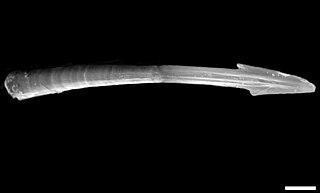
A love dart is a sharp, calcareous or chitinous dart which some hermaphroditic land snails and slugs create. Love darts are both formed and stored internally in a dart sac. These darts are made in sexually mature animals only, and are used as part of the sequence of events during courtship, before actual mating takes place. Darts are quite large compared to the size of the animal: in the case of the semi-slug genus Parmarion, the length of a dart can be up to one fifth that of the semi-slug's foot.
The reproductive system of an organism, also known as the genital system, is the biological system made up of all the anatomical organs involved in sexual reproduction. Many non-living substances such as fluids, hormones, and pheromones are also important accessories to the reproductive system. Unlike most organ systems, the sexes of differentiated species often have significant differences. These differences allow for a combination of genetic material between two individuals, which allows for the possibility of greater genetic fitness of the offspring.

Pseudunela cornuta is a species of minute sea slug, an acochlidian, a shell-less marine and temporarily brackish gastropod mollusk in the family Pseudunelidae. Adults are about 3 mm long and live in the spaces between sand grains.

Male accessory glands (MAG) in humans are the seminal vesicles, prostate gland, and the bulbourethral glands. In insects, male accessory glands produce products that mix with the sperm to protect and preserve them, including seminal fluid proteins. Some insecticides can induce an increase in the protein content of the male accessory glands of certain types of insects. This has the unintended effect of increasing the number of offspring they produce.

Leptacme cuongi is a species of air-breathing land snail, a terrestrial gastropod mollusk in the family Clausiliidae, the door snails.
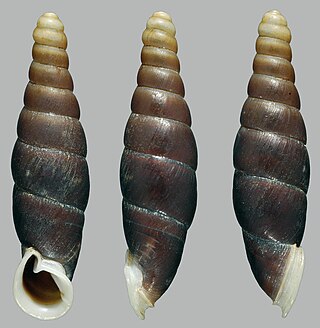
Atractophaedusa smithi is a species of air-breathing land snail, a terrestrial gastropod mollusk in the family Clausiliidae, the door snails.

The study of the genitalia of Lepidoptera is important for Lepidoptera taxonomy in addition to development, anatomy and natural history. The genitalia are complex and provide the basis for species discrimination in most families and also in family identification. The genitalia are attached onto the tenth or most distal segment of the abdomen. Lepidoptera have some of the most complex genital structures in the insect groups with a wide variety of complex spines, setae, scales and tufts in males, claspers of different shapes and different modifications of the ductus bursae in females.
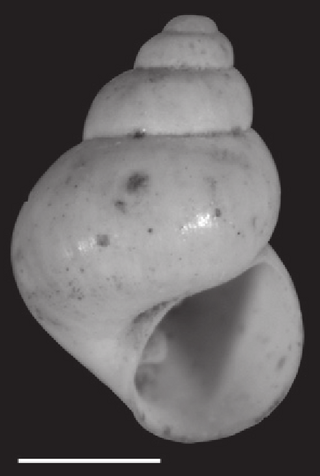
Marstonia comalensis is a species of minute freshwater snail with a gill and an operculum, an aquatic gastropod mollusk or micromollusk in the family Hydrobiidae. It is found in south central Texas, United States.
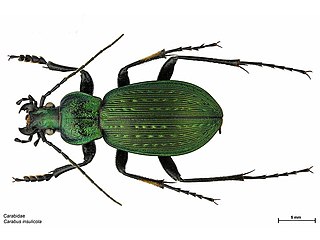
Carabus insulicola is a species of black-colored beetle from the family Carabidae native to Japan. They are also known as ground beetles. C. insulicola are oval shaped and elongated. They are black with a green metallic hue and vertical stripes running down their backs. The length of a fully grown beetle ranges from 27 to 31 mm. They have three pairs of legs and two pairs of wings. The outer wings are greatly degenerated, which prevents them from being able to fly. However, their relatively long legs allow them to walk and run fast. They have prominent mandibles that allow them to capture and eat prey.
Most insects reproduce oviparously, i.e. by laying eggs. The eggs are produced by the female in a pair of ovaries. Sperm, produced by the male in one testicle or more commonly two, is transmitted to the female during mating by means of external genitalia. The sperm is stored within the female in one or more spermathecae. At the time of fertilization, the eggs travel along oviducts to be fertilized by the sperm and are then expelled from the body ("laid"), in most cases via an ovipositor.

The mating of gastropods is a vast and varied topic, because the taxonomic class Gastropoda is very large and diverse, a group comprising sea snails and sea slugs, freshwater snails and land snails and slugs. Gastropods are second only to the class Insecta in terms of total number of species. Some gastropods have separate sexes, others are hermaphroditic. Some hermaphroditic groups have simultaneous hermaphroditism, whereas some sequential hermaphroditism. In addition, numerous very different mating strategies are used within different taxa.

The reproductive system of planarians is broadly similar among different families, although the associated structures can vary in complexity.
Roboastra tentaculata is a species of sea slug, a polycerid nudibranch, a marine gastropod mollusc in the family Polyceridae.


